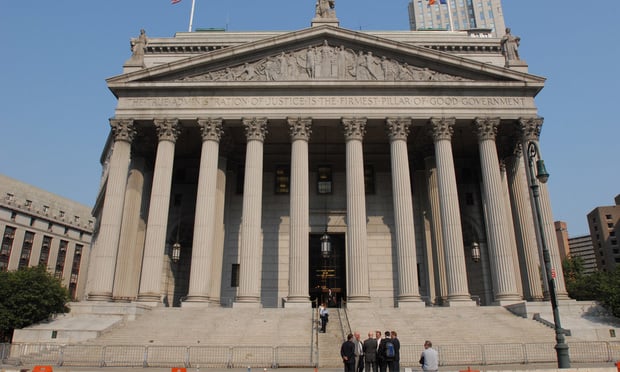NY Commercial Division Issues Rule Calling On Parties to Seek Earlier Resolutions
The court system has implemented a rule encouraging litigants to move for instant trials or evidentiary hearings in the early stages of a case when threshold matters arise.
July 25, 2018 at 06:17 PM
4 minute read
 It's a common occurrence in New York state courts: a civil case drags on for a few years, through extensive discovery and up to trial and, alas, it's determined that the case could have been thrown out long ago because it was But the court system has passed an amendment to the rules for the New York Commercial Division that could save parties from this pitfall. It has implemented a rule encouraging litigants to move for instant trials or evidentiary hearings in the early stages of a case when threshold matters arise. “All too often litigants engage in costly, broad-based litigation when a dispute might be resolved, settled or significantly narrowed in scope by targeting key issues for early limited discovery and an immediate evidentiary hearing or trial,” the Commercial Division Advisory Council wrote in a memo to recommend the new rule. “Early disposition, where proper, will conserve judicial and litigant resources.” Tracee Davis, a partner at Zeichner Ellman & Krause who serves on the advisory council and was the principal author of the new rule, noted that the rule is not creating new tools to expedite cases; these are options already provided for under New York's Civil Practice Law and Rules but often go underused. The “prevailing sense” among judges and practitioners, Davis said, has been to get all the discovery out of the way before trying evidentiary matters. “Let's do all of the discovery and try the matter in one fell swoop,” she said. But under the new measure it doesn't have to be this way. If a defendant raises, say, a statute-of-limitation defense early in the case that is tied to an issue of fact, the parties could hold an early trial on limited discovery pertaining to the defense, potentially avoiding future litigation. The rules also allow courts to appoint special referees to handle these early matters, who could issue a report to a judge for final approval. “It helps to eliminate the time and expense that would otherwise be exhausted on those other issue that are not ultimately dispositive,” Davis said. The rule also suggests that parties could use yet another often-overlooked method of resolving civil disputes that's already on the books. The amendment is the latest change to the Commercial Division's rules intended to help streamline operations. Last week, the division implemented a rule to encourage the practitioners and the courts to more widely embrace technology-assisted document review to potentially speed cases up. Bradley Rank, the managing attorney at Sheppard, Mullin, Richter & Hampton, said the Commercial Division has worked to present itself as a business-friendly venue, and moving cases through the system quickly will make it more attractive to litigants. “I think this new rule shows that the Commercial Division is really focused on resolving disputes in a cost-effective and expeditious manner wherever possible,” Rank said. But John Lundin, a partner at Schlam Stone & Dolan, said that, while finding ways to resolve cases more quickly is generally seen as a good thing, early hearings and trials might be a better fit for Commercial Division courts outside of Manhattan, where the monetary threshold for bringing cases is $500,000 (thresholds in Queens and Brooklyn, for example, are $100,000 and $150,000, respectively). Litigation in the Manhattan Commercial Division tends to be of a high-stakes nature—often seven- or eight-figure disputes, Lundin said; thus, there may be more incentive for practitioners and litigant there to explore every possible avenue. “As a practical matter, it's a question of how often it would be used, particularly in a place like New York County,” Lundin said.
It's a common occurrence in New York state courts: a civil case drags on for a few years, through extensive discovery and up to trial and, alas, it's determined that the case could have been thrown out long ago because it was But the court system has passed an amendment to the rules for the New York Commercial Division that could save parties from this pitfall. It has implemented a rule encouraging litigants to move for instant trials or evidentiary hearings in the early stages of a case when threshold matters arise. “All too often litigants engage in costly, broad-based litigation when a dispute might be resolved, settled or significantly narrowed in scope by targeting key issues for early limited discovery and an immediate evidentiary hearing or trial,” the Commercial Division Advisory Council wrote in a memo to recommend the new rule. “Early disposition, where proper, will conserve judicial and litigant resources.” Tracee Davis, a partner at Zeichner Ellman & Krause who serves on the advisory council and was the principal author of the new rule, noted that the rule is not creating new tools to expedite cases; these are options already provided for under New York's Civil Practice Law and Rules but often go underused. The “prevailing sense” among judges and practitioners, Davis said, has been to get all the discovery out of the way before trying evidentiary matters. “Let's do all of the discovery and try the matter in one fell swoop,” she said. But under the new measure it doesn't have to be this way. If a defendant raises, say, a statute-of-limitation defense early in the case that is tied to an issue of fact, the parties could hold an early trial on limited discovery pertaining to the defense, potentially avoiding future litigation. The rules also allow courts to appoint special referees to handle these early matters, who could issue a report to a judge for final approval. “It helps to eliminate the time and expense that would otherwise be exhausted on those other issue that are not ultimately dispositive,” Davis said. The rule also suggests that parties could use yet another often-overlooked method of resolving civil disputes that's already on the books. The amendment is the latest change to the Commercial Division's rules intended to help streamline operations. Last week, the division implemented a rule to encourage the practitioners and the courts to more widely embrace technology-assisted document review to potentially speed cases up. Bradley Rank, the managing attorney at Sheppard, Mullin, Richter & Hampton, said the Commercial Division has worked to present itself as a business-friendly venue, and moving cases through the system quickly will make it more attractive to litigants. “I think this new rule shows that the Commercial Division is really focused on resolving disputes in a cost-effective and expeditious manner wherever possible,” Rank said. But John Lundin, a partner at Schlam Stone & Dolan, said that, while finding ways to resolve cases more quickly is generally seen as a good thing, early hearings and trials might be a better fit for Commercial Division courts outside of Manhattan, where the monetary threshold for bringing cases is $500,000 (thresholds in Queens and Brooklyn, for example, are $100,000 and $150,000, respectively). Litigation in the Manhattan Commercial Division tends to be of a high-stakes nature—often seven- or eight-figure disputes, Lundin said; thus, there may be more incentive for practitioners and litigant there to explore every possible avenue. “As a practical matter, it's a question of how often it would be used, particularly in a place like New York County,” Lundin said.This content has been archived. It is available through our partners, LexisNexis® and Bloomberg Law.
To view this content, please continue to their sites.
Not a Lexis Subscriber?
Subscribe Now
Not a Bloomberg Law Subscriber?
Subscribe Now
NOT FOR REPRINT
© 2025 ALM Global, LLC, All Rights Reserved. Request academic re-use from www.copyright.com. All other uses, submit a request to [email protected]. For more information visit Asset & Logo Licensing.
You Might Like
View All
Justice 'Weaponization Working Group' Will Examine Officials Who Investigated Trump, US AG Bondi Says

Lawyers Across Political Spectrum Launch Public Interest Team to Litigate Against Antisemitism
4 minute read
'Landmark' New York Commission Set to Study Overburdened, Under-Resourced Family Courts

Trending Stories
- 1States Accuse Trump of Thwarting Court's Funding Restoration Order
- 2Microsoft Becomes Latest Tech Company to Face Claims of Stealing Marketing Commissions From Influencers
- 3Coral Gables Attorney Busted for Stalking Lawyer
- 4Trump's DOJ Delays Releasing Jan. 6 FBI Agents List Under Consent Order
- 5Securities Report Says That 2024 Settlements Passed a Total of $5.2B
Who Got The Work
J. Brugh Lower of Gibbons has entered an appearance for industrial equipment supplier Devco Corporation in a pending trademark infringement lawsuit. The suit, accusing the defendant of selling knock-off Graco products, was filed Dec. 18 in New Jersey District Court by Rivkin Radler on behalf of Graco Inc. and Graco Minnesota. The case, assigned to U.S. District Judge Zahid N. Quraishi, is 3:24-cv-11294, Graco Inc. et al v. Devco Corporation.
Who Got The Work
Rebecca Maller-Stein and Kent A. Yalowitz of Arnold & Porter Kaye Scholer have entered their appearances for Hanaco Venture Capital and its executives, Lior Prosor and David Frankel, in a pending securities lawsuit. The action, filed on Dec. 24 in New York Southern District Court by Zell, Aron & Co. on behalf of Goldeneye Advisors, accuses the defendants of negligently and fraudulently managing the plaintiff's $1 million investment. The case, assigned to U.S. District Judge Vernon S. Broderick, is 1:24-cv-09918, Goldeneye Advisors, LLC v. Hanaco Venture Capital, Ltd. et al.
Who Got The Work
Attorneys from A&O Shearman has stepped in as defense counsel for Toronto-Dominion Bank and other defendants in a pending securities class action. The suit, filed Dec. 11 in New York Southern District Court by Bleichmar Fonti & Auld, accuses the defendants of concealing the bank's 'pervasive' deficiencies in regards to its compliance with the Bank Secrecy Act and the quality of its anti-money laundering controls. The case, assigned to U.S. District Judge Arun Subramanian, is 1:24-cv-09445, Gonzalez v. The Toronto-Dominion Bank et al.
Who Got The Work
Crown Castle International, a Pennsylvania company providing shared communications infrastructure, has turned to Luke D. Wolf of Gordon Rees Scully Mansukhani to fend off a pending breach-of-contract lawsuit. The court action, filed Nov. 25 in Michigan Eastern District Court by Hooper Hathaway PC on behalf of The Town Residences LLC, accuses Crown Castle of failing to transfer approximately $30,000 in utility payments from T-Mobile in breach of a roof-top lease and assignment agreement. The case, assigned to U.S. District Judge Susan K. Declercq, is 2:24-cv-13131, The Town Residences LLC v. T-Mobile US, Inc. et al.
Who Got The Work
Wilfred P. Coronato and Daniel M. Schwartz of McCarter & English have stepped in as defense counsel to Electrolux Home Products Inc. in a pending product liability lawsuit. The court action, filed Nov. 26 in New York Eastern District Court by Poulos Lopiccolo PC and Nagel Rice LLP on behalf of David Stern, alleges that the defendant's refrigerators’ drawers and shelving repeatedly break and fall apart within months after purchase. The case, assigned to U.S. District Judge Joan M. Azrack, is 2:24-cv-08204, Stern v. Electrolux Home Products, Inc.
Featured Firms
Law Offices of Gary Martin Hays & Associates, P.C.
(470) 294-1674
Law Offices of Mark E. Salomone
(857) 444-6468
Smith & Hassler
(713) 739-1250






